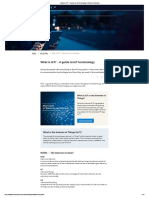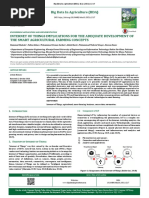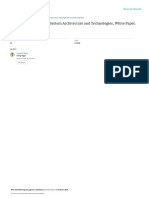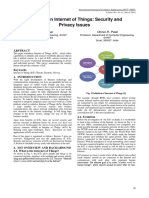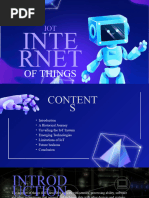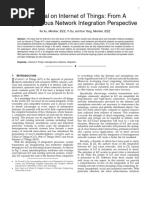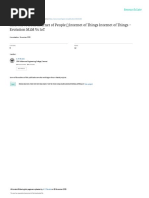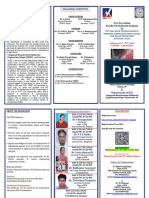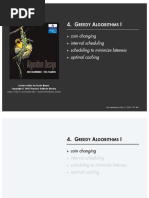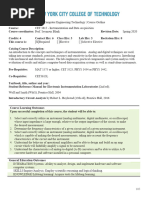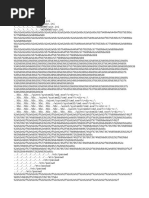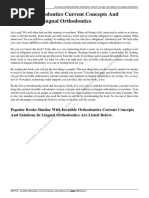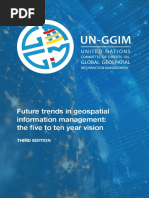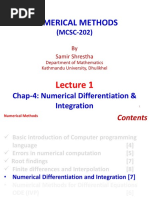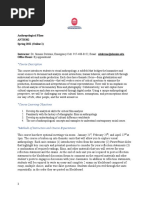Nptel Iot W1a
Nptel Iot W1a
Uploaded by
Nimmagadda Chandra PaulCopyright:
Available Formats
Nptel Iot W1a
Nptel Iot W1a
Uploaded by
Nimmagadda Chandra PaulOriginal Title
Copyright
Available Formats
Share this document
Did you find this document useful?
Is this content inappropriate?
Copyright:
Available Formats
Nptel Iot W1a
Nptel Iot W1a
Uploaded by
Nimmagadda Chandra PaulCopyright:
Available Formats
IoT
Internet technology connecting devices, machines and tools
to the internet by means of wireless technologies.
Introduction to IoT – Part I Over 9 billion ‘Things’ connected to the Internet, as of now.
‘Things’ connected to the Internet are projected to cross 20
billion in the near future.
Dr. Sudip Misra
Associate Professor Unification of technologies such as low-power embedded
Department of Computer Science and Engineering
IIT KHARAGPUR
systems, cloud computing, big-data, machine learning, and
Email: smisra@sit.iitkgp.ernet.in
Website: http://cse.iitkgp.ac.in/~smisra/
networking.
Introduction to Internet of Things 1 Introduction to Internet of Things 2
Origin of Terminology The title of the report was “Internet of Things”
Discussed the possibility of internet connected M2M connectivity
In the 2000s, we are heading into a new era of ubiquity, where networks, extending to common household devices.
the “users” of the Internet will be counted in billions and where Some areas identified as IoT enablers:
humans may become the minority as generators and receivers RFID,
Nanotechnology,
of traffic. Instead, most of the traffic will flow between devices
Sensors,
and all kinds of “things”, thereby creating a much wider and Smart Networks.
more complex Internet of Things.
(“The Internet of Things”, ITU Internet Report 2005) Reference: International Telecommunications Union (ITU). (2005). The Internet of Things. Executive Summary [Online]
Introduction to Internet of Things 3 Introduction to Internet of Things 4
Alternate Definition Characteristics
The Internet of Things (IoT) is the network of physical objects
Efficient, scalable and associated architecture
that contain embedded technology to communicate and sense
or interact with their internal states or the external Unambiguous naming and addressing
environment. Abundance of sleeping nodes, mobile and non-IP devices
Intermittent connectivity
Gartner Research
Reference: Teemu Savolainen, Jonne Soininen, and Bilhanan Silverajan,”IPv6 Addressing Strategies for IoT”, IEEE SENSORS
JOURNAL, VOL. 13, NO. 10, OCTOBER 2013
Reference: http://www.gartner.com/it-glossary/internet-of-things/
Introduction to Internet of Things 5 Introduction to Internet of Things 6
Business/Manufacturing
IoT Market Share
Real-time analytics of supply chains and equipment, robotic
machinery.
Healthcare
Portable health monitoring, electronic recordkeeping, pharmaceutical
safeguards.
Retail
Inventory tracking, smartphone purchasing, anonymous analytics of
consumer choices.
Security
Biometric and facial recognition locks, remote sensors.
Source: Intel
Introduction to Internet of Things 7 Introduction to Internet of Things 8
Evolution of Connected Devices ATM
These ubiquitous money dispensers went online for the first time way
back in 1974.
WEB
World Wide Web made its debut in 1991 to revolutionize computing and
communications.
SMART METERS
The first power meters to communicate remotely with the grid were
installed in the early 2000s.
DIGITAL LOCKS
Smartphones can be used to lock and unlock doors remotely, and business
owners can change key codes rapidly to grant or restrict access to
employees and guests.
Introduction to Internet of Things 9 Introduction to Internet of Things 10
SMART HEALTHCARE Modern Day IoT Applications
Devices connect to hospitals, doctors and relatives to alert them of
medical emergencies and take preventive measures. Smart Parking River Floods
SMART VEHICLES Structural health Smart Grid
Vehicles self-diagnose themselves and alert owners about system failures.
Noise Urban Maps Tank level
SMART CITIES
City-wide infrastructure communicating amongst themselves for unified
Smartphone Detection Photovoltaic Installations
and synchronized operations and information dissemination. Traffic Congestion Water Flow
SMART DUST Smart Lighting Silos Stock Calculation
Computers smaller than a grain of sand can be sprayed or injected almost Waste Management Perimeter Access Control
anywhere to measure chemicals in the soil or to diagnose problems in the
human body. Smart Roads Liquid Presence
Introduction to Internet of Things 11 Introduction to Internet of Things 12
Modern Day IoT Applications Expected!!
Forest Fire Detection Radiation Levels
Air Pollution Explosive and Hazardous Gases
Sensors
Snow Level Monitoring
Landslide and Avalanche Prevention
Earthquake Early Detection
Supply Chain Control
NFC Payment
Intelligent Shopping Applications
Trillions Smart Systems
Billions
Applications IoT
Water Leakages Smart Product Management Millions
Introduction to Internet of Things 13 Introduction to Internet of Things 14
IoT Enablers Connectivity Layers
Introduction to Internet of Things 15 Introduction to Internet of Things 16
Baseline Technologies IoT vs. M2M
A number of technologies that are very closely related to IoT M2M refers to communications and interactions between machines and
devices.
include
Such interactions can occur via a cloud computing infrastructure
Machine-to-Machine (M2M) communications, (e.g., devices exchanging information through a cloud infrastructure).
Cyber-Physical-Systems (CPS) M2M offers the means for managing devices and devices interaction,
Web-of-Things (WoT). while also collecting machine and/or sensor data.
M2M is a term introduced by telecommunication services providers and,
pays emphasis on machines interactions via one or more
telcom/communication networks (e.g., 3G, 4G, 5G, satellite, public
networks).
Introduction to Internet of Things 17 Introduction to Internet of Things 18
IoT vs. M2M IoT vs. WoT
M2M is part of the IoT, while M2M standards have a prominent place in From a developer's perspective, the WoT enables access and
the IoT standards landscape. control over IoT resources and applications using mainstream
However, IoT has a broader scope than M2M, since it comprises a broader web technologies (such as HTML 5.0, JavaScript, Ajax, PHP,
range of interactions, including interactions between devices/things,
things and people, things with applications and people with applications.
Ruby n' Rails etc.).
It also enables the composition of workflows comprising all of the above The approach to building WoT is therefore based on RESTful principles
interactions. and REST APIs, which enable both developers and deployers to benefit
from the popularity and maturity of web technologies.
IoT includes the notion of internet connectivity (which is provided in most
of the networks outlined above), but is not necessarily focused on the use Still, building the WoT has various scalability, security etc. challenges,
of telcom networks. especially as part of a roadmap towards a global WoT.
Introduction to Internet of Things 19 Introduction to Internet of Things 20
IoT vs. WoT Terminological Interdependence
While IoT is about creating a network of objects, things, people,
systems and applications, WoT tries to integrate them to the Web.
Technically speaking, WoT can be thought as a flavour/option of an
application layer added over the IoT's network layer. However, the
scope of IoT applications is broader and includes systems that are
not accessible through the web (e.g., conventional WSN and RFID
systems).
Introduction to Internet of Things 21 Introduction to Internet of Things 22
Introduction to Internet of Things 23
You might also like
- NNCE-Student-Guide 23.1.0 v2Document339 pagesNNCE-Student-Guide 23.1.0 v2tothcsabatamasNo ratings yet
- DSL-340 MkIII Operators Manual V1.3Document67 pagesDSL-340 MkIII Operators Manual V1.3Kien Pham100% (1)
- Matlab Programming For Numerical Computation - Unit 4 - Module 2 - Errors and ApproximationsDocument6 pagesMatlab Programming For Numerical Computation - Unit 4 - Module 2 - Errors and Approximationsparth bhardwajNo ratings yet
- Internet of Things - : Applications & ProspectsDocument158 pagesInternet of Things - : Applications & ProspectsakttripathiNo ratings yet
- Smart World of Internet of Things (Iot) and It'S Security ConcernsDocument6 pagesSmart World of Internet of Things (Iot) and It'S Security ConcernsSanjay ShekarNo ratings yet
- Internet of Things (Iot) : For Freshman StudentsDocument37 pagesInternet of Things (Iot) : For Freshman StudentsghhhhhhhhhhhhhhhhfrtvcfgNo ratings yet
- Dec50132 Internet Based Controller Iot-Chapter 1Document30 pagesDec50132 Internet Based Controller Iot-Chapter 1JustShareItNo ratings yet
- Chapter 4 - IoTDocument30 pagesChapter 4 - IoTmlhd1055No ratings yet
- Chapte 3 IoTDocument36 pagesChapte 3 IoTeyuelalemnew123No ratings yet
- Internet of Things Application Using Tethered MSP430 To Thingspeak CloudDocument6 pagesInternet of Things Application Using Tethered MSP430 To Thingspeak CloudMichelle LlamatumbiNo ratings yet
- PID2566391 - Future Internet - The Internet of Things ArchitectureDocument5 pagesPID2566391 - Future Internet - The Internet of Things ArchitecturePool Espejo ConchaNo ratings yet
- Ijsrp Published Research Paper November 2020Document10 pagesIjsrp Published Research Paper November 2020Shoaib Ul HassanNo ratings yet
- An Analysis of Internet of Things (Iot) : Novel Architectures, Modern Applications, Security Aspects and Future Scope With Latest Case StudiesDocument27 pagesAn Analysis of Internet of Things (Iot) : Novel Architectures, Modern Applications, Security Aspects and Future Scope With Latest Case StudiesCak RizNo ratings yet
- Pre Final EMERGING TECHNOLOGY ReviewerDocument7 pagesPre Final EMERGING TECHNOLOGY Reviewerjamescastor98No ratings yet
- Chapter 4: Internet of Things (Iot)Document18 pagesChapter 4: Internet of Things (Iot)CherianXavierNo ratings yet
- Internet of Things - Analysis and Challenges: Ar ClesDocument11 pagesInternet of Things - Analysis and Challenges: Ar ClesRajiv GargNo ratings yet
- Week-1 ADocument23 pagesWeek-1 AMahesh MaheshwariNo ratings yet
- Module 4Document16 pagesModule 4Sheshagiri SheshuNo ratings yet
- Lecture On IOT 2023Document55 pagesLecture On IOT 2023Nurfauza JaliNo ratings yet
- .Internet of Things-IOT Definition, Characteristics, Architecture, Enabling Technologies, Application & Future ChallengesDocument10 pages.Internet of Things-IOT Definition, Characteristics, Architecture, Enabling Technologies, Application & Future ChallengesBobby Chin SinghNo ratings yet
- Chapter Four Internet of Things (Iot) : Iot Services+ Data+ Networks + SensorsDocument14 pagesChapter Four Internet of Things (Iot) : Iot Services+ Data+ Networks + SensorsAbdataa waaqaaNo ratings yet
- (IJCST-V6I3P18) :ahmed AbdiDocument8 pages(IJCST-V6I3P18) :ahmed AbdiEighthSenseGroupNo ratings yet
- Iot Final Research PaperDocument12 pagesIot Final Research PaperRavi RanjanNo ratings yet
- Internet of Things: Basic Telecom TechologyDocument14 pagesInternet of Things: Basic Telecom TechologyRanjitha C RNo ratings yet
- alahari 2017 ijca 912973 هذا PDFDocument5 pagesalahari 2017 ijca 912973 هذا PDFكن صديقيNo ratings yet
- Industrial Internet of Things: Applying Iot in The Industrial Context Professor Duncan Mcfarlane University of CambridgeDocument16 pagesIndustrial Internet of Things: Applying Iot in The Industrial Context Professor Duncan Mcfarlane University of CambridgeLakshay Sharma100% (1)
- An Exploration About Frameworks Based On Green Internet of ThingsDocument5 pagesAn Exploration About Frameworks Based On Green Internet of ThingsProjects MNo ratings yet
- IoT NPTELDocument1,243 pagesIoT NPTELstrawberry shortcakeNo ratings yet
- Internet of Things (Iot) : A Brief Information and Challenges of ImplementingDocument3 pagesInternet of Things (Iot) : A Brief Information and Challenges of ImplementingNarender Reddy KampelliNo ratings yet
- What Is IoT - A Guide To IoT Terminology PDFDocument14 pagesWhat Is IoT - A Guide To IoT Terminology PDFsartgNo ratings yet
- Protocols LandscapeDocument3 pagesProtocols Landscapenapoleon_velasc3617No ratings yet
- Internet of Things-IOT: Definition, Characteristics, Architecture, Enabling Technologies, Application & Future ChallengesDocument13 pagesInternet of Things-IOT: Definition, Characteristics, Architecture, Enabling Technologies, Application & Future ChallengesAndreea IlieNo ratings yet
- Chapter 3 IoTDocument20 pagesChapter 3 IoTJunnel MalabananNo ratings yet
- Introduction To Iot - Part I: Dr. Sudip MisraDocument23 pagesIntroduction To Iot - Part I: Dr. Sudip MisraabdulmuqueemNo ratings yet
- Introduction To Iot - Part I: Dr. Sudip MisraDocument23 pagesIntroduction To Iot - Part I: Dr. Sudip Misrammit123100% (2)
- 2011 - Research On The Key Technologies of IOT Applied On Smart GridsDocument4 pages2011 - Research On The Key Technologies of IOT Applied On Smart GridsAnkit SoniNo ratings yet
- AnkushDocument28 pagesAnkushcamioNo ratings yet
- ijcatr10051003Document4 pagesijcatr10051003Karthik NadarNo ratings yet
- IOT Based System Design Unit IDocument14 pagesIOT Based System Design Unit Idhanush23022004No ratings yet
- IoT Paper Big DataDocument6 pagesIoT Paper Big DataMuhammad Uzair GhaniNo ratings yet
- Io TSystem Architectureand TechnologiesDocument6 pagesIo TSystem Architectureand TechnologiesJoão GimenesNo ratings yet
- Evolution of Internet of Things From Blockchain ToDocument24 pagesEvolution of Internet of Things From Blockchain TojavedtarlilNo ratings yet
- Internet of Things and Libraries: Shamprasad M Pujar and K V SatyanarayanaDocument5 pagesInternet of Things and Libraries: Shamprasad M Pujar and K V Satyanarayanaforget44551758No ratings yet
- Emerging Note (C4-6) #2 @NoteHeroBotDocument115 pagesEmerging Note (C4-6) #2 @NoteHeroBotkbk3mohNo ratings yet
- Chapter 4 - IOTDocument44 pagesChapter 4 - IOTsenait getachewNo ratings yet
- Iot Security Privacy PDFDocument7 pagesIot Security Privacy PDFserignemodouNo ratings yet
- Chapter 4 - IOT-modifiedDocument51 pagesChapter 4 - IOT-modifiedGamselo SelogamsNo ratings yet
- IOT Control Appliances GSM GPRSDocument3 pagesIOT Control Appliances GSM GPRSshahbaz75sbNo ratings yet
- Paper 50-Security Issues in The Internet of ThingsDocument7 pagesPaper 50-Security Issues in The Internet of ThingsAlti AdelNo ratings yet
- Internet of Things (Iot) /cloud Computing: Prameet P. PatilDocument6 pagesInternet of Things (Iot) /cloud Computing: Prameet P. PatilPrameet P PatilNo ratings yet
- Kumar 2018Document6 pagesKumar 2018sowande.obaloluwaNo ratings yet
- IOT Project PresentationDocument13 pagesIOT Project Presentationnikksssss666No ratings yet
- a_tutorial_on_internet_of_things_-_from_a_heterogeneous_network_integration_perspectiveDocument9 pagesa_tutorial_on_internet_of_things_-_from_a_heterogeneous_network_integration_perspectiveSAMNo ratings yet
- Lecture 03Document42 pagesLecture 03natnaelNo ratings yet
- Internet of Things Lecture Material (B.tech ECE IV-I)Document92 pagesInternet of Things Lecture Material (B.tech ECE IV-I)anniepersiasNo ratings yet
- Mid Seminar ReportDocument18 pagesMid Seminar ReportAdnan50% (4)
- Idea: Move From Internet of People Internet of Things Internet of Things - Evolution M2M Vs IotDocument26 pagesIdea: Move From Internet of People Internet of Things Internet of Things - Evolution M2M Vs IotAbdoulaye MbayeNo ratings yet
- Idea: Move From Internet of People Internet of Things Internet of Things - Evolution M2M Vs IotDocument26 pagesIdea: Move From Internet of People Internet of Things Internet of Things - Evolution M2M Vs IotAbdoulaye MbayeNo ratings yet
- IOT Final 1Document6 pagesIOT Final 1keshavk3524No ratings yet
- EmergingDocument32 pagesEmergingMillion TolessaNo ratings yet
- The Internet of Things: Living in a connected worldFrom EverandThe Internet of Things: Living in a connected worldBCS, The Chartered Institute for ITNo ratings yet
- Internet of Things (IoT): Introduction to IoT. Advancements and Communication Protocols. Part 1From EverandInternet of Things (IoT): Introduction to IoT. Advancements and Communication Protocols. Part 1No ratings yet
- Unit 5 NotesDocument34 pagesUnit 5 NotesNimmagadda Chandra PaulNo ratings yet
- OC Unit-5 ProblemsDocument7 pagesOC Unit-5 ProblemsNimmagadda Chandra PaulNo ratings yet
- OC Unit-4 ProblemsDocument18 pagesOC Unit-4 ProblemsNimmagadda Chandra PaulNo ratings yet
- Notice BoardDocument4 pagesNotice BoardNimmagadda Chandra PaulNo ratings yet
- FDP Brochure - ECEDocument2 pagesFDP Brochure - ECENimmagadda Chandra Paul100% (1)
- Https:/docs Arduino Cc/resources/datasheets/a000066-Datasheet PDFDocument13 pagesHttps:/docs Arduino Cc/resources/datasheets/a000066-Datasheet PDFNimmagadda Chandra PaulNo ratings yet
- 04 Greedy Algorithms IDocument44 pages04 Greedy Algorithms IAlexandar MahoneNo ratings yet
- CET3615Document4 pagesCET3615aaxxx dxxx rxxxx gxxxNo ratings yet
- GCS Manual enDocument98 pagesGCS Manual enMy dirveNo ratings yet
- Click UpDocument3 pagesClick UpoioiioNo ratings yet
- Ai MLDocument1 pageAi MLvishwas shettyNo ratings yet
- Rekordbox 6 ShortcutsDocument4 pagesRekordbox 6 Shortcutsassanebakayoko58No ratings yet
- Class 4 Sample Questions: International Informatics Olympiad - IIO 2019Document1 pageClass 4 Sample Questions: International Informatics Olympiad - IIO 2019Reyansh JainNo ratings yet
- CoCubes - Syllabus EngineeringDocument3 pagesCoCubes - Syllabus EngineeringGaurav Prakash AnaraseNo ratings yet
- Invisible Orthodontics Current Concepts and Solutions in Lingual OrthodonticsDocument1 pageInvisible Orthodontics Current Concepts and Solutions in Lingual OrthodonticsHafaifa TaiebNo ratings yet
- P "D" P M: Elco Rotocol AnualDocument19 pagesP "D" P M: Elco Rotocol AnualmunusamyNo ratings yet
- Anurag - Hacking With ExpertsDocument128 pagesAnurag - Hacking With ExpertsProsper Emonena0% (1)
- 6OSI ReferencemodelDocument43 pages6OSI Referencemodelgokul adethyaNo ratings yet
- COMPOSERDocument720 pagesCOMPOSERfxvNo ratings yet
- Alarm Device ListDocument5 pagesAlarm Device Listluiz carlos bonafini jrNo ratings yet
- S2ma2021122104wbf1-N-11 Po28Document4 pagesS2ma2021122104wbf1-N-11 Po28imad maanenNo ratings yet
- Gimac - 1000 - Catalog - ENDocument13 pagesGimac - 1000 - Catalog - ENTotoroNo ratings yet
- Future Trends Report THIRD EDITION Digital AccessibleDocument82 pagesFuture Trends Report THIRD EDITION Digital Accessibleabhishek dikshitNo ratings yet
- LUMIX Video AF Guidebook 211201Document31 pagesLUMIX Video AF Guidebook 211201Teodor CapmariNo ratings yet
- MCSC202 Theory Chap 4 Lec 1Document53 pagesMCSC202 Theory Chap 4 Lec 1BinoNo ratings yet
- Nx100 Instruction ManualDocument308 pagesNx100 Instruction ManualLiew Yew SinNo ratings yet
- Reviewer For EmpTech 2nd QuarterDocument4 pagesReviewer For EmpTech 2nd QuarterryzachristinelacapNo ratings yet
- ANTH FILM Spring 2021 SyllabusDocument9 pagesANTH FILM Spring 2021 SyllabusKatherine RecklingNo ratings yet
- Part-A Cnc Vertical Turning Lathe - Table Φ 4000Mm: Section - I: Qualifying CriteriaDocument47 pagesPart-A Cnc Vertical Turning Lathe - Table Φ 4000Mm: Section - I: Qualifying CriteriaiR DesignNo ratings yet
- Sourabh23_Resume (4)Document1 pageSourabh23_Resume (4)sdhaker2No ratings yet
- Topic 1a - Introduction To Data MiningDocument12 pagesTopic 1a - Introduction To Data MiningNurizzati Md NizamNo ratings yet
- Steve Jobs - An Entrepreneurial VisionaryDocument3 pagesSteve Jobs - An Entrepreneurial VisionarymridubalaakNo ratings yet
- CloudGenix ION 7000 Hardware Data SheetDocument1 pageCloudGenix ION 7000 Hardware Data SheetGS MeenaNo ratings yet





























